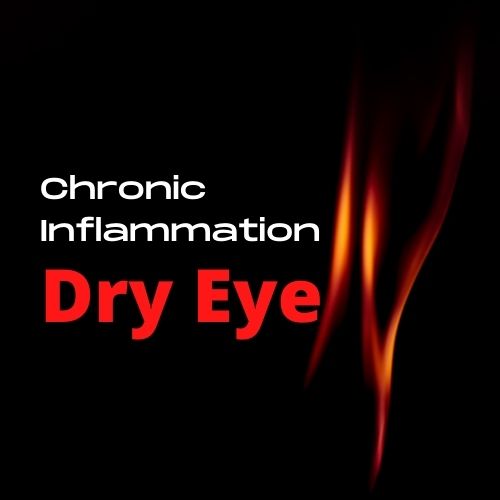Chronic Inflammation May Cause Your Dry Eye


Chronic inflammation may likely cause your dry eye.
Dry eye is a common condition that affects about 49 million Americans. According to Google Trends internet searches for “dry eye syndrome” doubled between December 2010 to July 2020.
Symptoms of Dry Eye
If you suffer from dry eyes you have experienced these common symptoms:
- Stinging, burning, scratching sensations in your eye
- Gritty feeling in your eyes as though something is in your eyes
- Red eyes
- Watery eyes
- Sensitivity to light
- Tired/fatigued eyes
- Blurred vision
- Difficulty tolerating contact lenses
- Eyelids sticking together
There are many causes of dry eye and some are as simple environmental issues, such as living in a dry climate, being out in the wind or around other types of hot blowing air. But in this article we are going to consider the link between inflammation and dry eye disease.
How Inflammation Causes Dry Eye
The inflammatory response is naturally triggered when body tissues are injured by bacteria, trauma, toxins, heat, or other causes and the damaged cells release chemicals such as histamine and prostaglandins. These chemicals cause blood vessels to leak fluid into the tissues causing swelling. This response isolates the foreign/harmful substance from damaging adjacent tissues. The chemicals also attract a white blood cells called phagocytes that “eat” the germs and dead or damage cells.
But in some cases, the inflammatory response is triggered without cause. When that happens, the condition is called an autoimmune disorder or disease. There are more than 80 autoimmune diseases known to medical researchers. Some are well known, such as lupus, rheumatoid arthritis, type 1 diabetes, and multiple sclerosis.
Autoimmune Diseases
Having an autoimmune disease creates chronic inflammation. The inflammatory response gets triggered and attacks healthy tissues. Sometimes that inflammation is in the lacrimal (tear) glands, the cornea, or the conjunctiva of the eye and they all can cause a disruption in the production of tear film.
Tear Film and Chronic Inflammation
Tear film has three layers—oil, water, and mucus. Tear film also consists of proteins, electrolytes, and salt. The top layer of tear film is oil that is produced by the meibomian glands. The oil layer smooths the tear surface and slows down the rate of evaporation.
Inflammation along the edge of the eyelids is called blepharitis and can cause the meibomian glands to become blocked. Chronic inflammation can also affect the lacrimal glands where the aqueous layer of tear film is produced. The cornea (transparent front part of the eye) and conjunctiva (the mucous membrane that covers the front of the eye and lines the inside of the eyelids) can also be affected by chronic inflammation.
If your dry eye disease is a result of chronic inflammation, drugs that block the immune response may help eliminate your dry eye symptoms. Some of the anti-inflammatory drugs used to treat dry eye are:
- Cyclosporine (Restasis)
- Lifitegrast (Xiidra)
- Varenicline nasal spray (Tyrvaya)
- Corticosteroids
- Antibiotics
If you have dry eyes and artificial tears are not relieving your symptoms, make an appointment with the eye care practitioner and find out if your dry eye is caused by chronic inflammation.
Gregory Scimeca, M.D.
Ophthalmologist and Medical Director
The Eye Professionals
Our Locations
